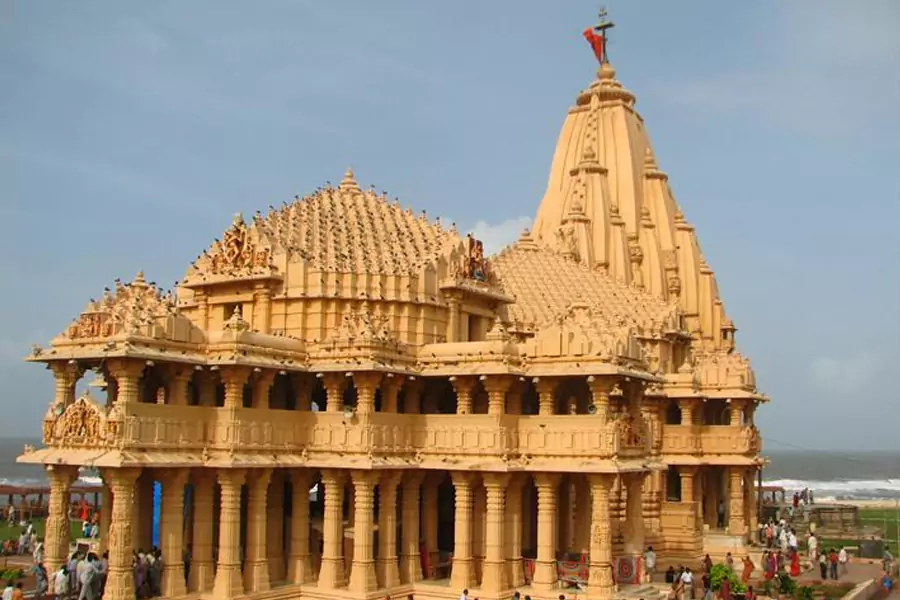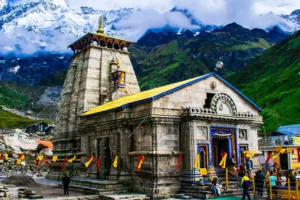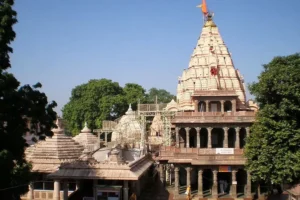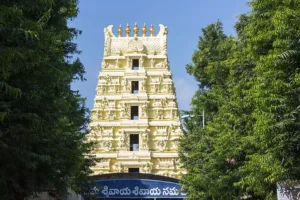Somnath Temple
The Somnath Temple, carved in warm honey-colored stone, stands proudly on the western edge of Gujarat. It marks the site where the first of the twelve sacred jyotirlingas appeared, as Lord Shiva manifested in a blazing column of light. The temple rises at the confluence of the Kapila, Hiran, and Saraswati rivers, with the Arabian Sea washing its shores. Its origins trace back to 649 BC, though many believe it existed long before that era. The current structure, completed in 1951, reflects timeless architectural beauty. In the temple gardens, colorful dioramas narrate tales of Shiva, while a sound-and-light show voiced by Amitabh Bachchan captivates visitors every evening at 7:45 pm.
Somnath Temple Key Features
- Architectural Marvel: Built in the Chalukya style, the temple showcases intricate carvings, sculptures, and fine detailing.
- Spiritual Importance: As the first Jyotirlinga, it symbolizes Shiva’s endless divine light.
- Cultural Center: The temple hosts religious rituals, festivals, and cultural gatherings throughout the year.
Somnath Temple History
According to legends, Somraj—the moon god—first built this shrine in gold. Ravana later rebuilt it in silver, Lord Krishna in wood, and Bhimdev in stone. The present-day temple, designed in traditional style on its original coastal site, shines in a creamy hue with intricate sculptures. At its sanctum lies the revered black Shiva lingam, one of the twelve jyotirlingas worshipped across India.
The temple’s fame spread far beyond India through the writings of Persian scholar Al-Biruni. In 1025 CE, Mahmud of Ghazni invaded Somnath, drawn by its immense wealth. At that time, the temple employed hundreds of artists, dancers, and attendants. After a two-day battle that claimed nearly 70,000 lives, Mahmud looted the temple’s treasures and destroyed the structure. This tragedy repeated itself several times in history, with further demolitions in 1297, 1394, and 1706 under Mughal ruler Aurangzeb.
After India gained independence, Somnath rose again. In 1950, Sardar Vallabhbhai Patel initiated its reconstruction as a symbol of cultural pride and resilience. The foundation stone was laid on November 12, 1947, and the temple we see today stands as a monument of faith and strength.
Historical Timeline
- Ancient Origins: References in the Puranas and the Mahabharata mention Somraj, the Moon God, as the builder of the original shrine.
- Medieval Period: The temple suffered several invasions, including the infamous attack by Mahmud of Ghazni in 1026 CE. Hindu rulers later rebuilt it multiple times.
- Modern Reconstruction: In 1951, the temple was reconstructed under the guidance of Sardar Vallabhbhai Patel, preserving its sacred heritage.
Key Events
- First Invasion: Mahmud of Ghazni destroyed the temple in 1026 CE and looted its wealth.
- Rebuilding Efforts: Hindu dynasties such as the Paramaras, Chalukyas, and Marathas reconstructed the shrine repeatedly.
- Modern Era: After independence, Indian leaders, led by Sardar Patel, restored the temple on its original coastal site.
Somnath Temple Location
The temple is located at Prabhas Patan, near Veraval, in the Saurashtra region of Gujarat.
Geographical Details:
- Coordinates: 20.8880° N, 70.4010° E
- Distance: 7 km from Veraval, 82 km from Junagadh, and about 400 km from Ahmedabad.
Nearby Attractions:
- Bhalka Tirth: Believed to be the site where Lord Krishna was struck by an arrow.
- Triveni Sangam: The sacred confluence of the Hiran, Kapila, and Saraswati rivers.
Somnath Temple Timings
The temple follows a well-organized schedule, allowing devotees to experience darshan and rituals peacefully.
Daily Schedule:
- Morning Darshan: 6:00 AM – 12:00 PM
- Afternoon Darshan: 12:30 PM – 6:30 PM
- Evening Darshan: 7:00 PM – 9:30 PM
Special Timings:
- Aarti: 7:00 AM, 12:00 PM, and 7:00 PM
- Light and Sound Show: Held in the evening, narrating the temple’s history.
Best Time to Visit Somnath Temple
The best time to visit Somnath Temple is between October and February, when the weather remains pleasant. Devotees especially flock here during Shivratri (February–March) and Kartik Purnima (around Diwali), when the temple comes alive with vibrant celebrations.
Seasonal Guide:
- Winter (October – March): Pleasant climate, best for sightseeing and temple visits.
- Monsoon (July – September): Moderate to heavy rains; less ideal for travel.
- Summer (April – June): Hot temperatures but fewer crowds.
Festivals and Events:
- Mahashivratri: Celebrated with grandeur, drawing thousands of devotees.
- Kartik Purnima: Marked with special prayers and rituals around Diwali.
How to Reach Somnath Temple
Somnath is well connected by air, rail, and road, making it accessible from major cities.
1.) By Air
- Nearest Airport: Diu Airport (85 km).
- Other Options: Rajkot (195 km) and Ahmedabad (400 km).
- Connectivity: Frequent flights from Mumbai, Delhi, and Ahmedabad.
- Travel Tip: Hire a taxi or take a bus from the airport to the temple.
2.) By Train
- Nearest Station: Veraval Railway Station (7 km).
- Major Trains: Direct trains from Ahmedabad, Rajkot, and Mumbai.
- Travel Tip: Local transport like taxis and auto-rickshaws are easily available.
3.) By Bus
- State Transport: GSRTC runs regular buses to Somnath.
- Private Operators: Buses available from major cities; online booking is simple.
- Ahmedabad to Somnath bus booking
- Bharuch to Somnath bus booking
- Surat to Somnath bus booking
- Ankleshwar to Somnath bus booking
- Travel Tip: Choose from budget, semi-luxury, or luxury buses as per preference.
Local Transport:
- Auto-rickshaws and taxis: Convenient for short distances.
- Car rentals: Offer a comfortable option for nearby sightseeing.
Conclusion
The Somnath Temple is more than a pilgrimage site—it is a symbol of India’s cultural heritage and unshakable devotion. With its awe-inspiring architecture, powerful history, and serene coastal setting, it is a must-visit for devotees and travelers alike. Whether you seek spiritual peace or want to explore history, Somnath promises an unforgettable experience. Plan your visit with this guide for a smooth and enriching journey to the “Eternal Shrine.”





